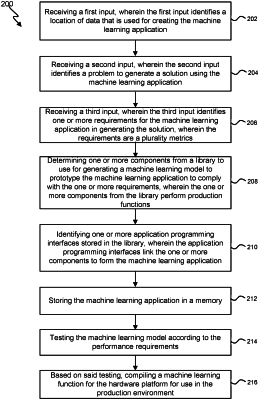| CPC G06N 5/04 (2013.01) [G06F 40/40 (2020.01); G06N 20/00 (2019.01); G06N 20/20 (2019.01); H04L 51/02 (2013.01)] | 20 Claims |

|
1. A computer-implemented method comprising:
receiving, from a user device, a first input;
predicting, using a computational technique, a type of desired result based on the first input;
identifying, using metadata associated with each machine-learning-model framework of a set of machine-learning-model frameworks, one or more machine-learning-model frameworks based on the predicted type of desired result, wherein the one or more machine-learning-model frameworks are of the set of machine-learning-model frameworks;
presenting, for each machine-learning-model framework of the one or more machine-learning-model frameworks, a representation of a corresponding machine-learning-model architecture on a display, wherein one or more machine-learning-model architectures are presented;
receiving a second input identifying a selection of a particular machine-learning-model architecture of the one or more machine-learning-model architectures;
receiving a third input identifying a data source for generating a machine learning architecture;
receiving a fourth input identifying one or more constraints for the machine learning architecture;
generating code for a machine learning model based at least in part on the second input identifying the selection of the particular machine-learning-model architecture, the third input identifying the data source, and the fourth input identifying the one or more constraints; and
storing the generated code in a memory.
|